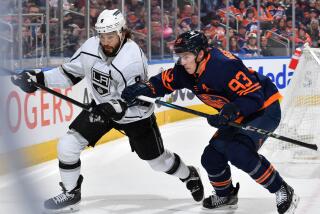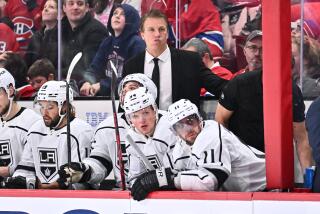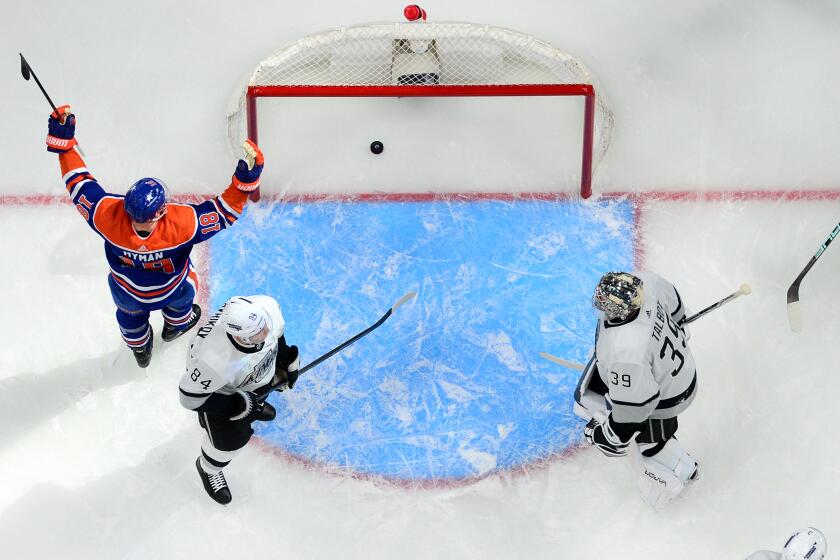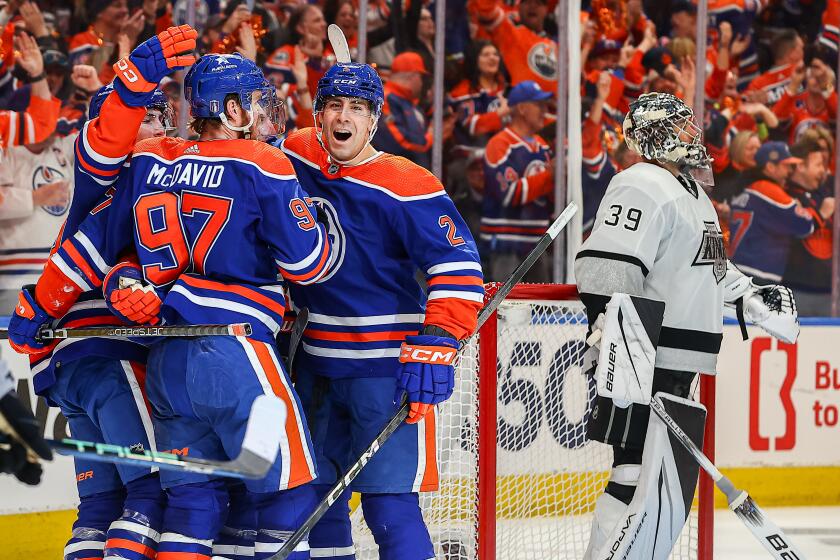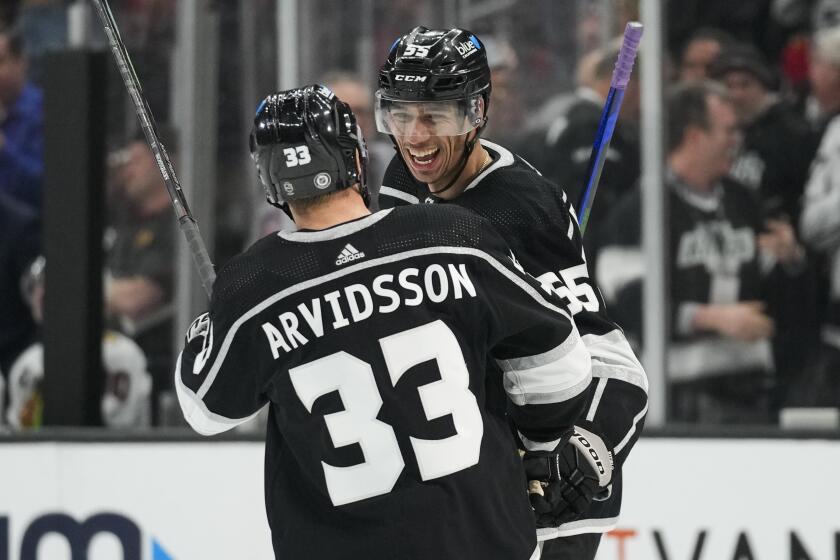There’s an art to NHL teams’ slick-as-ice line changes
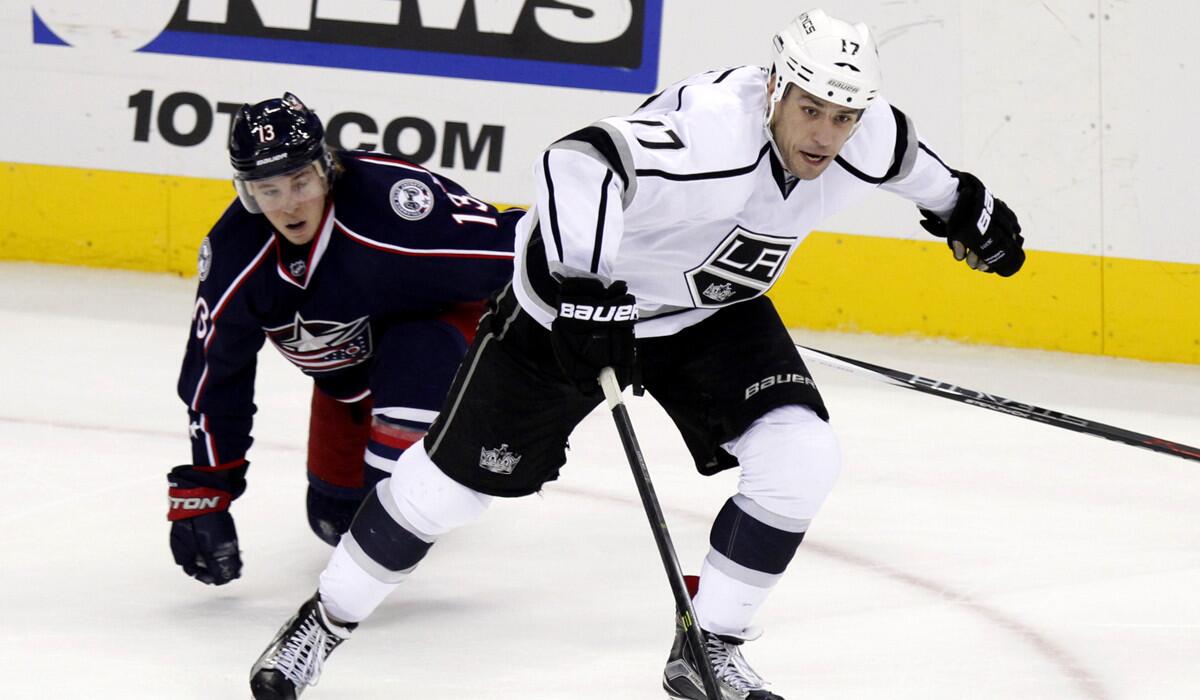
Los Angeles Kings’ Milan Lucic, right, works for the puck against Columbus Blue Jackets’ Cam Atkinson during a game on Tuesday.
Admittedly, I watch live hockey in a semiconscious state of beery delirium, just like everyone else.
Yet even when I force myself to focus, I still don’t fully understand NHL line changes. There seems to be no rhyme or reason to how they occur “on the fly” — the term for changing lines in the middle of all the mayhem.
Like a fire drill without an alarm, NHL substitutions appear to take place artfully, triggered by some mysterious bugle call.
But how?
This might remain one of those life puzzles that are just going to elude mere mortals, much like string theory or why Kanye West insists on wearing kilts. Or why L.A. Live, dressed for Christmas, looks like Caligula’s closet.
Perhaps you have to grow up with line changes. My own hockey career came exclusively on frozen ponds, where we played the sport the way it was meant to be played — skating without rest till you yacked in a snowbank after guzzling too much Pepsi.
In pond hockey, the only time you’d sub out a guy was if he fell through the ice and nearly drowned (which happened a lot more than moms realized).
So, despite 50 years of casually following the sport, I’ve decided to demystify these frantic jailbreaks, because many L.A. fans probably don’t really understand line changes either.
“Shifts are only 35 seconds, sometimes you get a minute,” explains former player and longtime radio analyst Daryl Evans.
To start a line change, Evans says, the head coach will call out the center’s name, and that line will race onto the ice as the other comes off — NHL rules allow for a small overlap of players near the bench.
Most teams, including the Kings and Ducks, use four front lines of two wingers and a center. On defense, there are three units of two players, and most changes come after a team sends the puck into the opponents’ zone, often giving up an attack in exchange for fresh legs.
This is where “on the fly” line changes get intriguing: The chess match between coaches becomes apparent as they seek out situational mismatches. For example, if a team can get its No. 1 line against an opponent’s weakest defenders, it has an obvious edge.
“Used to be forward line against forward line,” says Jim Fox, the Kings’ exceptional TV analyst. “In the last five years, it’s become more about getting matchups against defenders.”
Head coaches usually call line changes for the forwards, while assistants — such as the Kings’ associate head coach John Stevens -— handle defenders.
“I think some guys look for matchups more than others,” Fox says, noting that veteran coaches generally have a better feel for the strategy and rhythms that on-the-fly changes require.
In short, a team executing smooth line changes, at proper 35-second increments, is going to stay fresher and be better paced than a team that is out of sync.
“It’s an intangible in a game that can really affect the dynamic,” Fox explains.
Another line-change nuance — and one you probably knew: When play stops, the visiting team must put its players on the ice first, giving the home team the advantage of setting the matchups.
Meanwhile, choppy line changes — like a penchant for penalties — can be a sign of a lack of leadership, or a side effect of fatigue.
In 2014, a tired Kings team gave up two goals to the Chicago Blackhawks on bungled line changes in a Game 4 loss in the Western Conference finals, before coming back to win their second Stanley Cup, against the New York Rangers.
Bluffs can play into the rotation as well. Fox notes how Anze Kopitar is adept at extending a shift for a couple of extra seconds to deke an overeager opposing coach looking to rest his horses.
In the past, a team desperate for a shift change might ice the puck for a chance to get exhausted players out.
“This year, when you ice the puck you can’t change players,” Fox says of a recent rule change.
Also new this year, of course, the wonderful three-on-three overtimes, where shift changes are even more hectic — and potentially risky. Fox notes that teams are starting to figure out three on three, by passing the puck back to the goalie to allow time for a line change.
Any questions? I have no answers, only an obsessive need to understand this amazing and arcane game.
And yes, when I was a kid, I fell through the ice a lot.
Twitter: @erskinetimes
More to Read
Go beyond the scoreboard
Get the latest on L.A.'s teams in the daily Sports Report newsletter.
You may occasionally receive promotional content from the Los Angeles Times.
